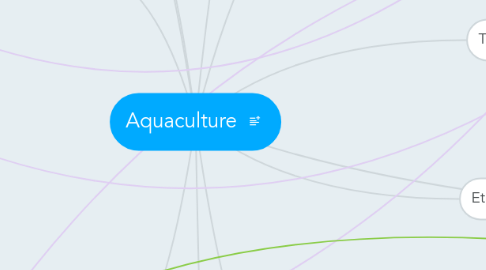
1. Sustainability
1.1. The practice of sustainability cannot be built upon unsustainability
1.1.1. Ie. Shrimp farming in 'wild' mangroves doesn't work
1.2. Economy
1.2.1. Financial viability
1.2.2. Resource use efficiency
1.2.3. Successful integration with environment is necessary for optimum practices
1.2.4. Supply & demand
1.3. Environment
1.3.1. Impact on marine life population
1.3.1.1. Non-native species
1.3.1.1.1. Dependence on such
1.3.1.1.2. Compete with native
1.3.1.2. Overfishing
1.3.2. Impact of climate change
1.3.2.1. "The frequency and intensity of extreme climate events is likely to have a major impact on future fisheries production in both inland and marine systems."
1.3.3. Pollution & Diseases
1.3.3.1. Chemical waste
1.3.4. Water quality degradation
1.3.4.1. Eutrophication
1.3.4.1.1. Algae blooms
1.3.4.2. Oxygen depletion
1.3.5. Mangrove deforestation
1.3.6. fish feed
1.4. Successful models
1.4.1. (Ocean Futures Society)
1.4.2. Artificial reef
1.4.3. Possibly microalgae food
1.4.4. Thai aquaculture
2. Management & Regulation
2.1. Currently lacking. Would be more sustainable with better foresight/planning/management
2.2. Farming practice
2.2.1. Fish waste build-up bad for bottom-dwelling life
2.2.1.1. Waste handling
2.2.2. Some carnivorous/omnivorous fish eat wild forage fish
3. Politics
3.1. Legislation
4. Present and Future
4.1. Rate of change
4.2. Predicted outcomes
4.3. Aquaculture environment interactions: Past, present and likely future trends by Peter Edwards 2015
5. Energy & Resources
5.1. Sustainability
5.1.1. Production system waste
5.1.1.1. Uneaten food, chemicals, pathogens
5.1.1.2. Escaping fish
5.2. Industrial chain of command
5.2.1. ...and their environmental practices
5.3. "interactions and conflicts among available resources"
5.4. Fish feed
6. Ethics
6.1. Human health
6.2. Animal treatment
6.3. Land use
6.3.1. Native peoples
6.3.2. Sensitive ecology
7. Fish quality & By-products
7.1. Side effects of anti-biotics
7.2. Fish not as good as wild re. fish oils
8. Technology
8.1. Cost of practices & labour
9. Alternative/s
9.1. Fisheries
9.1.1. "There is no capacity for any increase in seafood production from fisheries... Seafood production from fisheries has thus plateaued at about 90 million tonnes per year over the past two decades (Figure 1B). "
9.2. Fishing (wild)
9.2.1. Fishing makes for few & small fish sensitive to climate change
9.3. Local fishing & global production
10. Social/Cultural
10.1. Developing countries
10.2. Infrastructure
10.2.1. Jobs
10.3. Public education
11. Info
11.1. Types
12. Articles
13. Body
13.1. Economy
13.1.1. Politics
13.1.2. Social
13.2. Environment
13.3. Successes & Alternatives
13.3.1. Aquac. past present future
14. Why we need it
14.1. "Fisheries are solely related to catching wild fish or raising and harvesting fish through aquaculture or fish farming. ...[F]isheries can be saltwater or freshwater, wild or farmed"
14.2. Not just food industry
14.2.1. "culturing crocodiles for their skins and culturing freshwater mussels to produce ∼2,000 tonnes of pearls per year for jewellery"
14.2.2. "Seaweeds are mainly produced for chemicals that are extracted from them and used in organic beauty products and alternative pharmaceuticals. The main chemical is ‘alginate’, which has a very high affinity for water and forms a strong gel. Sodium alginate is widely used as a stabiliser, thickener, binder and emulsifier, especially in foods."
14.3. It's the most sustainable option
14.3.1. Fish depletion- fishing vs aquaculture
14.4. Accounts for much of industry and economy
14.4.1. "Production from aquaculture reached 90 million tonnes in 2012 and has passed fisheries as the major source of global seafood (Figure 1B)."
